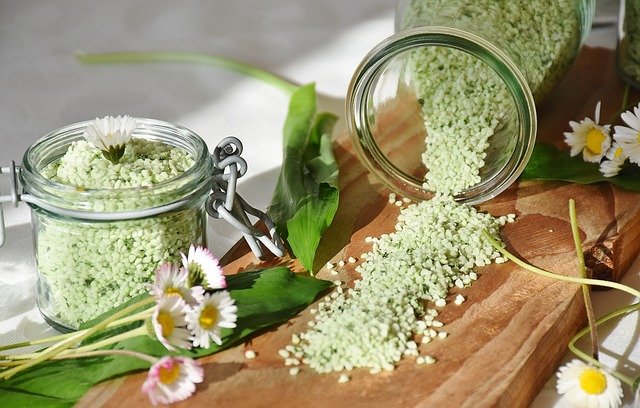
Wild garlic, also known as wild garlic, is an edible spontaneous plant with a more delicate flavor than traditional garlic. Let’s see the benefits and how to use it in the kitchen.
Wild garlic or wild garlic belongs to the Liliacee family, the same family to which onions , asparagus, chives, leeks, garlic and shallots belong.
It is a perennial wild plant that has numerous properties, the most important being the reduction of cholesterol, the control of pressure and the antibacterial effect . Each part of the plant is edible and in the kitchen you can use all its parts, with which you can make many recipes. Compared to traditional garlic , it has a more delicate flavor and is more digestible.
What is wild garlic
Wild garlic is a “wild” variety of garlic and is a perennial aromatic plant that blooms from April to June. Like many other wild plants it is possible to find it in the woods, especially near rivers, or in any case in humid environments. Despite this, it is increasingly cultivated also as an ornamental or kitchen plant.
The plant is characterized by three parts: the bulb, whitish in color, from which the green, fleshy, oval-shaped and aromatic leaves start, with a smell similar to garlic especially when they are cut. The white colored flowers look like an umbrella-shaped inflorescence.
The name “bear” has been attributed to this plant because it seems that bears are very greedy for it and tend to eat large quantities of it upon awakening from hibernation.
Wild garlic: nutritional values and calories
Wild garlic is mainly composed of water (about 63% of its weight) and has nutritional values very similar to common garlic. Therefore the energy intake is around 40 kcal per 100g of wild garlic. What distinguishes wild garlic from common garlic is the higher content of vitamins, especially vitamin C and thiamine (or vitamin B1) as well as some active ingredients such as allisin and allinase (which together form allicin), sulfur compounds responsible for many of the properties and benefits of this plant. Let’s now explore this aspect and try to understand what bear garlic is good for.
What is wild garlic good for?
Here are properties and benefits Wild garlic has health benefits that are very similar to the properties of common garlic. In particular, it exerts an antibacterial action, improves cholesterol and blood pressure values, stimulates the immune system and has a potential oncological prevention activity. Let’s explore all the benefits of wild garlic below.
✓ Antibacterial action
The use of garlic as an antimicrobial and antibacterial dates back to the period of the First World War. Today, several scientific studies have observed that this action is linked to the presence of allicin contained in both common garlic and bear garlic. In particular, allicin is also effective against microorganisms that are often resistant to some antibiotics; an important case concerns the ability of allicin to inhibit streptococcus aureus, a microorganism often resistant to antibiotics and responsible for many hospital infections.
✓ Reduces cholesterol
Wild garlic is able to reduce cholesterol levels thanks to the presence of sulfur-containing compounds that act directly on the synthesis of cholesterol, inhibiting it. Furthermore, the consumption of ramsons helps to increase HDL cholesterol, also known as “good” cholesterol, which protects the arteries from the formation of atherosclerosis.
✓ Control of blood pressure
Consuming wild garlic helps lower blood pressure. In particular, a study compared the blood pressure values of those who consumed the common garlic with those of those who consumed wild garlic, finding a greater reduction in blood pressure in the group that took wild garlic (orsino).
✓ Antitumor
Also thanks to the presence of allicin, bear garlic also helps in cancer prevention. Specifically, this effect is given once again by the presence of allicin, which is able to induce the death of cancer cells (apoptosis). Furthermore, bear in mind that wild garlic contains sulfur compounds, also known for their anticancer activity and always being studied in the prevention of cancer.
✓ Improves the immune response
Vitamin C and allicin contained in ramsons stimulate the activity of immune cells by improving the body’s defenses. Remember that vitamin C has an important antioxidant effect that strengthens the cells of the immune system so that they can fight viruses and bacteria more effectively.
How much wild garlic to consume to get benefits
There is no minimum consumption dosage of wild garlic to obtain the benefits. Despite this, it is understood that it must not be used in excessive quantities, but all its parts can be used for the preparation of recipes, pesto or even to make herbal teas or decoctions. As with common garlic, however, it is recommended not to exceed one or two cloves per day.
What does bear garlic taste like
The taste of wild garlic is similar to chives, therefore, when using it in the kitchen it is good to remember that it has a more delicate taste than common garlic but which also gives the aroma and scent of garlic.
How to use wild garlic in cooking
In the kitchen it is possible to use all parts of the wild garlic, the leaves and flowers must be carefully washed with water, while the bulb must be cleaned of any residues of earth and then peeled.
It is often used in place of traditional garlic, in particular the leaves can be added chopped to summer salads, to flavor boiled or baked potatoes or to flavor an omelette or meat or fish dishes. Wild garlic leaves are also used together with basil for an aromatic pesto with which to season pasta.
As for the bulb, its use in the kitchen is very similar to that of normal garlic, in fact after being peeled it can be added both chopped and crushed to give a delicate aroma of garlic to the sauté, to sauces, but also to soups. and soups.
Finally, the wild garlic flowers can also be used to prepare liqueurs but also to flavor cheeses.
Alternative uses of wild garlic
This aromatic herb also lends itself to other uses, for example the leaves and flowers can be used both fresh and dried to prepare herbal teas and decoctions. On the market it is possible to find the mother tincture of wild garlic, but also masks and tonics for the face used above all for the treatment of acne given the known antibacterial properties of this plant. In addition, several ramson -based supplements have been formulated to exploit its beneficial properties for health.
Wild garlic vs Traditional garlic: main differences
Wild garlic has nutritional characteristics very similar to traditional garlic, it differs only for a higher content of phyto-compounds and vitamins.
While the dried bulb is mainly used for traditional garlic, we can consume all its parts of wild garlic and, despite the aroma and aroma reminiscent of traditional garlic, the flavor is more delicate and similar to that of grass chives.
Another feature that distinguishes wild garlic from traditional garlic is its better digestibility, in fact, those who do not digest garlic can use it instead of traditional garlic, especially in recipes and preparations that involve the use of raw garlic.
Does bear garlic also negatively affect breath?
While the aroma and flavor of wild garlic are reminiscent of traditional garlic, it actually affects the breath much less . In any case, it is possible to combine wild garlic with parsley, sage, thyme and rosemary which help neutralize the smell and taste.
Wild garlic: contraindications and possible interactions
There are no known side effects of wild garlic. In any case, it is preferable not to use excessive quantities if you are taking medications to control blood pressure and blood sugar since episodes of hypotension and hypoglycemia could occur. Furthermore, for pregnant and lactating women there are no contraindications in the use of wild garlic as an ingredient in various recipes and preparations, while it is necessary to ask your doctor for advice if you use wild garlic for decoctions, herbal teas or in the form of a food supplement.
Where can you buy wild garlic?
For those who do not feel like going into the woods in search of wild garlic, it is possible to buy wild garlic in the fruit-growing department of supermarkets and well-stocked greengrocers. Alternatively, you can buy the plant to grow in the garden or on the terrace at nurseries or garden stores. Finally, dried bear’s garlic is available, especially in the online shops of organic products.






